| RACING HISTORY |
YEAR: 1991
PEOPLE
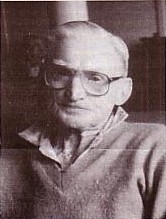 |
The death occurred at the weekend of the successful trainer and sportsman, Alf Bourne.
Widely known as 'Ginger', Bourne was a jockey, boxer and footballer. He was in his prime in the 1930s, playing breakaway for the Canterbury rugby team, and in 1933 he beat Bill Pascoe to take the NZ heavyweight boxing title. He was a loyal Merivale man, coaching the senior team and later became a life member.
He spent more than 50 years training horses, including many that reached top class. Waitaki Hanover, who won the Hunter Cup in Melbourne, the Auckland Cup, the Rotorua Cup, the Flying Handicap and the Summer Cup in Sydney, was one of the best. He had a soft spot for Mister Chips because he used to get homesick and cheer up as soon as he returned home, and with the ill-fated Vanderford he won 11.
After winning four races for Don Hayes, Vanderford joined Bourne's stable, and won six in succession at the start of his 4-year-old campaign, notably the Methven Cup off 48yds, the Laing Handicap from Rustic Lad and Flying Blue, the Flying Stakes at Ashburton from Robin Dundee and Cardigan Bay, and the Hannon Memorial. He was the beaten favourite in the NZ Cup won by Cardigan Bay. He was never so good at five, where his only win was at Forbury Park.
Vantage, Larnie Scott, Doctor Scott and the speedy trotter Al Mundy were among other good horses he trained.
Aged 81 at the time of his death, Bourne continued to follow sport, especially rugby which he loved so much, during his retirement.
Credit: Mike Grainger writing in HRWeekly 9Oct91
YEAR: 1991
PEOPLE
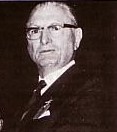 |
Though he maintained a very low profile in horse racing, Auckland brewery baron and philanthropist Sir Henry Kelliher, who died recently aged 95, was an enthusiastic and sporadically successful breeder of standardbreds and thoroughbreds.
Sir Henry will probably be remembered best in harness racing for giving Aucklander Mrs Audrey Dean's champion pacer Cardigan Bay a luxurious retirement at his island paradise, Puketutu, in the Manukau Harbour. From Match 1970 until Cardigan Bay died aged 31 in March 1988, Sir Henry doted over the internationally famous gelding, who attracted thousands of tourists from around the world to see in the flesh the first pacer to win a million dollars. "I think he must be the most photographed horse in the world," Sir Henry would often proudly say.
But Sir Henry's involvement in the standardbred sport went much deeper. His crowning achievement was to rank as the breeder of 1979 Inter-Dominion Grand Champion pacer Rondel, who was imported to NZ in embryo inside the Light Brigade mare Light Rendez. From the noted First Water family, Light Rendez had been bought in Australia on Sir Henry's behalf by Noel Simpson, and covered by the Simpson-imported American stallion Berra Hanover.
Mary Hall, a Dillon Hall mare bought from Canterbury as a breeding proposition by Sir Henry, produced a fine winner in Monsignor for Whenuapai trainer Ray Norton, while Magli, Mary Hall's 1953 foal by Loreto, left Terraton, a classic winning filly for Noel Taylor.
One of the best trotters produced in NZ, Easton Light, owes his place in immortality to Sir Henry's generosity. It was in the late 1950s when Dennis, son of Eric and Thelma Running, who were farming at East Tamaki, developed a nervous disorder that led to double pneumonia and other complications. Following hospitalisation and almost nine months in a recuperative home, Dennis returned home to mend further. To get him interested in moving around and out in the open air, Eric decided to get him a pony.
After Eric approached Puketutu stud master Jack Bainbridge, it was reasoned a pony might be too frisky. The upshot was that Sir Henry gave the Runnings an eight-year-old gelding with a deformed foot named Graham Logan, whom he had bred from a Black Globe mare, Indian Globe. Graham Logan had been tried on lease by Auckland trainer Horry Keogan and, after registering just one third placing in 14 attempts, returned to Puketutu Island with no future in sight.
When Dennis Running tired of his pet, his father, who had learned the rudiments of training horses when a freezing worker with the late Jack Brophy at Timaru in the 'forties', decided to have a go at training Graham Logan to win a race. Taking Graham Logan to the races as a 10-year-old in 1962/63, Running won three trotting races with him. It led to Eric carrying on in the game and eventually winning fame and fortune with Easton Light, NZ's biggest trotting winner to this time with 36 victories, including two Dominion Handicaps and a Rowe Cup, for $132,370.
As a thoroughbred breeder, Sir Henry earned distinction through Mister Pompous, the good Canterbury galloper of the early 1970s, while several Puketutu-based stud stallions to make an impression on New Zealand and Australia racing were headed by Ivory Hunter.
Long-term patron of the Auckland Trotting Owners, Trainers and Breeders' Association and the first patron and a grand supporter of the NZ Trotting Hall of Fame, and an occasional sponsor of juvenile pacing events in Auckland, Sir Henry refrained from racing horses in his own right.
For a non-owner, he possessed a remarkable command of bloodlines, while, probably from his early days as a third generation child of a Central Otago farming family, he had a love of horses that shone through whenever he escorted guests around the paddocks and stables of the lush Puketutu Island that was his home for half a century.
Credit: Ron Bisman writing in HRWeekly
YEAR: 1991
PEOPLE
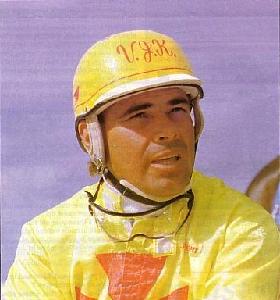 |
There seems no sense to make of the tragic death of Vincent John ("Vinny") Knight. Dashing, dark and handsome, Vinny was an Australian harness racing celebrity.
He took off as a young rebel in his teens, but he learned his lessons quickly. At a young age, only 36, there was little he hadn't achieved. Hard work, natural ability, a competitive spirit and a desire to succeed quickly took him beyond the pack.
In the early 1980's, he became well-known through the wonderful efforts of Popular Alm. He would say of 'Poppy'..."He made good horses, real good horses, look like idiots. He had everything. He had freak ability. He was a aristocrat when he walked onto the track. Everybody was proud just to look at the horse - 'there is Poplular Alm, isn't he a great horse'- and he looked a good horse. He had everything. If he had been a human being, everybody would have flocked all over him. He was just a beautiful horse, I have never had one better than him, and never will."
After that his success rate flourished. For the past three seasons Knight has driven horses that have totalled more than $1 million in stakes. He has driven more than 700 winners in Melbourne: no-one's done that before. He has won 18 Inter-Dominion heats; he has been leading Melbourne reinsman five times. The great horses he has driven include Jane Ellen, Sinbad Bay, Smooth Falcon, Our Maestro, Jodie's Babe, Alpine Fella, Panyan, Thor Lobell, Koala Knight, Rockleigh Victory, Allan Grant and Almeta Boy.
Off the track, he was deeply affected by the death of his mother Aileen, and the booing of Bag Limit after his sensational win in the 1988 Winfield Cup upset him. "She was a very proud lady. She just loved to go and watch me drive. After Mum died, it was probably the hardest time of my life," he told Bob Cain in the Trotting Weekly.
Knight was hurt by the crowd demonstration after he had spent hours getting Bag Limit to the post for the Cup. "When you work with horses seven days a week, it upsets you when they start booing after the race. They might have been booing me, but I could see them booing 'Baggie.' He didn't deserve that. he tried his guts out every time he went to Moonee Valley. He didn't deserve any boos. I feel for my horses; I love 'em."
Speculation and rumour will persist on other pressures that surrounded his life in the fast lane, for no doubt he had them. Vinny was extremely popular. Whenever he was in New Zealand, he was often attended by a clutch of stable followers and fans. In some ways, Vinny was to the harness racing industry what film star James Dean was to the American youth in the early 1950's.
Such image-makers are few and far between. Like all larger-than-life personalities taken in their prime, Vinny wasn't here long enough.
Credit: Mike Grainger writing in HRWeekly 17Apr91
YEAR: 1991
PEOPLE
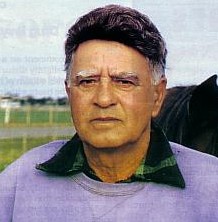 |
This month marks the end of driving for Gavin Hampton, now aged 65. Having driven 250 winners since being first licenced in the 1946-47 season, he retires thinking how fortunate he was to train two of them. Near the start of his career, in 1952 and 53, he had Masterpiece and 29 years ago it was the handsome stallion, Radiant Globe.
He wouldn't separate the two on ability, though Masterpiece won him 6 and Radiant Globe 22. "The best was never seen of Masterpiece. I got him when he had won five and he won me six, including four on end. He had great speed. You could bring him into the straight about seventh or eighth and he would produce a brilliant finish; he was a better horse if you held him up."
An unsound son of Light Brigade, Masterpiece started his trot for Hampton by winning at Hutt Park, where he beat Inglewood, and then defeated First Victory at Addington. He went to Ashburton on Boxing Day, winning from Tribal Song and Tiberius, and brought up his fourth successive win in the Au Revoir Handicap at Addington from Vedette, Zulu and Dragoman. His sixth and final win of his career came the same season at Addington, where he won from Lauder Hall, Petite Yvonne and Maida Dillon.
"Radiant Globe was a lovely horse, a great horse to have round the place, and the kids could get on and ride him. You knew he was always going to do his best for you."
Hampton's best driving tally was in the 1970-71 season when he won 21 and Radiant Globe gave him eight of them, including the Greymouth Cup from Barrhill and Jacquinot Bay, and the New Brighton Cup from True Averil and Barrhill. It was also the season of his greatest disappointment. "The 1971 Inter-Dominions were at Addington, and he couldn't start on the first night because he got tied up. On the second night he ran fourth and he won on the third night with a faster rate than any of the other three winners (Stella Frost, Manaroa and Rain Again). He missed out on a start in the Final by one point." To illustrate the good prospect he would have been in the Final, Radiant Globe won the 13 furlong Consolation from Globe Bay by more than six lengths in 3:27, after Stella Frost took 3:38 2/5 in the Grand Final. "I was lucky to get a horse like that," he said.
Hampton's first job was at Takanini at F J Smith's Village Farm. It was a top stable, including at the time Josedale Dictator and Volo Senwood. You had to pick up all you learned, but it was different than what it is these days. He had 11 boys on the staff and they each had two horses to look after and they were strapped for an hour and a quarter every day. "It was three months before I got my first day off, and six months before I was allowed in the cart," he said.
His first winning drive was after he had returned south, to where his father Joe was training at East Eyreton in North Canterbury. "My father wasn't very pleased about it. I drove Rowan McCoy at Greymouth, where it was usual to have two starts in the day. In the first of them, when he was paying £100 to win, I miscounted the number of rounds, and got him going to run fourth. I won with him later in the day, but he was hot favourite then," he said.
He gained a professional licence in 1950 and moved to Belfast, where Masterpiece - later the sire of top pacer Master Alan - and the U Scott trotter Ecosse joined the team. Cara Nelson was another good winner at the time, and in the early 60s he produced Wendy Dawn to win the NZ Oaks and the Nelson Cup, and Belmartial to win the NZ Trotting Stakes. In 1966, he moved to Weedons, where he trained and drove such good winners as Glen Bell, Final Donn, Pineship, Grovenor Globe, and Radiant General who won the 1975 Golden Slipper Stakes.
His driving successes included the Westport Cup behind Slick Chick, the Superstars Final with Lucky Boy, the NZ Free-For-All with Radiant Globe, feature races with Stampede and Zabadak, and the Canterbury Park Cup behind Philemon.
Hampton has noticed great changes in the style of driving in recent years. "It used to be stereotyped, but now it's all hustle and bustle. People are going for the money and they seem to under more pressure. When I first started you would follow someone who would show you how to get the gaps, like Maurice Holmes. I had my first drives for the season at Nelson last month and I couldn't get over it. I would think I'd be going alright, in a good position, then I'd find myself out the back. It's a different ballgame now," he said.
For many years a committeeman on the Trainers and Drivers Association, Hampton considers the Conference could have involved more professional men in some of its decision-making, and worries about the little protection for cadets after they leave the scheme. "It seems too easy to get a licence, and this must have an effect on the future of the young ones."
"The cost and pressure doesn't make harness racing as enjoyable as it used to be," he said. Hampton, whose last driving success was in the 1987-88 season, did not have his first drives this season until the recent Nelson meeting. He leased Parklane for the curcuit, and hopes to end his career driving the same horse at Addington - the scene of his most memorable wins.
Credit: Mike Grainger writing in HRWeekly 3Jul91
YEAR: 1991
INTERDOMINIONS
AUCKLAND - MARK HANOVER
In many ways, Mark Hanover's win in the 1991 Auckland Inter Dominion came as a highlight for Roy Purdon's illustrious career. He part owned the horse and trained him along with his son Barry. The horse was named after another son, Mark who drove him to victory. For good measure the stable provided the quinella with Christopher Vance being driven by Roy's son in law, Tony Herlihy.
YEAR: 1991
HORSES
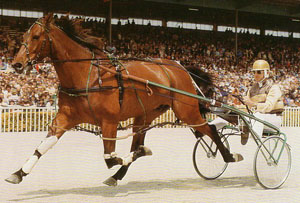 |
| Young Quinn parades at Addington |
Young Quinn (1:55 and $759,000), the winner of 59 races in New Zealand, Australia and North America, had to be humanely destroyed at Ota Creek, Eastern Southland, last Friday, aged 22. Old age crept up on the great gelding, who was being troubled by the onset of arthritis. Rather than see him suffer, owners Bud and Des Baynes had him put down by a veterinarian.
Young Quinn's passing deprives harness racing of one of its favourite sons. Southlanders will be quick to acknowledge he was bred and developed in their province, but the Young Charles gelding was also a great favourite in Auckland and Waikato where he was trained and raced from Charlie Hunter's Cambridge quarters. He had only two other trainers - Bud Baynes and Clem Scott. Jim Doherty served as his American caretaker trainer for a period and said Young Quinn was the finest horse he handled.
North Americans also took him to their hearts, the secretaries of harness racing clubs overwhelmingly voting him 1976 Aged Pacer of the Year. And Sydney harness racing fans marvelled at his 1975 Miracle Mile triumph from the extreme outside draw on the half mile track. He arrived in Sydney only the day before and many stated he could not win from the outside slot.
Young Quinn, a champion in the true sense, often overcame the odds, such was his class and courage. He also mastered the extreme outside draw in his 1976 American Pacing Classic triumph at Hollywood Park, California. Opposing horseman, the legendary Billy Haughton, said 'Quinn' could not win, because of the draw. For the very same reason, Haughton scratched his own representative and rival, who had drawn one closer in than Young Quinn. Reined by the great Joe O'Brien, who outfoxed his rivals, Young Quinn drove straight to the front, then trailed, and pulled out late to win.
Young Quinn often looked an equine man among boys, such was his commanding stature and presence. He stood 16.1 hands high and electrocardiographs revealed an exceptional heart score of 138, which might account in some degree for his stamina, hardiness and ability to recover. Young Quinn was once warmly dubbed the worlds fastest knee knocker. He brushed his front knees and, for that reason, generally preferred the bigger racing strips with more gradual bends.
All racing scribes are sometimes guilty of abusing the term champion. It can be an occupational hazard. After all, it is only natural to become a little carried away with outstanding horses. But nobody could deny 'Quinn' the dubbing of champion. Seasoned horsemen and critics rightly point out that Young Quinn had his record indelibly carved on the international slate. He met and mastered the best on three continents.
Young Quinn grappled with several crack pacers during the mid and late 1970s on the hectic USA Free-For-All circuit. After all, his foes, Nero, Handle With Care, Peter Lobell, Rambling Willie, Tarport Hap, Nickawupas Leroy, Sir Delrae and others were integral components of that highly competitive scene. 'So was Quinn'. "Simply, he was a brilliant and genuine free-for-aller in the top bracket...that is one thing I will always treasure about him," Des Baynes recalled of his star.
Des and his father Bud claim his 1972 NZ Sapling Stakes and 1975 Inter-Dominion Grand Final triumphs were arguably his greatest wins in this country. He was stopped in his tracks in the early stages of the Sapling Stakes, having only two behind him at the mile. Bob Cameron's clever horsemanship played a big part in his remaining on his feet and in the Sapling contest. He also lost ground early in the 1975 Grand Final, but charged to a memorable victory in the then youthful hands of John Langdon, substituting for his tutor Charlie Hunter.
Champions attract many accolades, but very few have a track named after them. The Wyndham Harness Racing Club's 1460 metre strip in the famed Lower Mataura Valley, a birthplace of champions, is named the Young Quinn Raceway. That honour will always serve as a tangible reminder of his champion qualities and popularity. Young Quinn actually bowed out of the public limelight when paraded with other greats at Addington on Cup Day, 1985. The Baynes men certainly played their part in parading him at other venues for his fans to admire.
But for recurring problems with check ligaments, Young Quinn would have probably won over $1 million. But his connections did not want to run the risk of racing him too much and breaking him down. Young Quinn's fourth in Delightful Lady's 1980 Auckland Cup was one of his finest efforts. That was his second start as a 10-year-old on his return to NZ from North America.
The winner of the 1974 edition of the race, he was retired to live out his days in peace after the 1980 Auckland Cup. He always lived out his retirement off the fat of the land on the lush Baynes property at Ota Creek. Genuine horsemen feel for their favourites. Bud Baynes demonstrated that to the very last. While burying the great gelding, he took every precaution to do things properly. He was still mindful of the fact that he didn't want to do anything that might 'hurt' the old horse when he was laying him to rest. Young Quinn certainly commanded respect to the very last. He always will.
Credit: Don Wright writing in HRWeekly 20Nov91
YEAR: 1991
HORSES
INKY LORD
Dynamic, charismatic, electrifying, courageous - these four words sum up the qualities which made Inky Lord one of the most popular horses ever to grace the tracks of New Zealand.
It is now seven days since the Adington faithful watched, in stunned disbelief, as desperate attempts were made to revive Inky Lord after he collapsed following the New Zealand Cup trial at Addington. And, having hand-timed Inky Lord throughout the trial myself, I found it hard to believe a horse who had just completed his task so well could - barely seconds later - have life snatched away. A post-mortem revealed Inky Lord suffered a ruptured aorta. There was no way the horse could be saved.
Inky Lord was a vibrant source of enjoyment for his legion of fans, as well as the people who bred, reared, owned, trained and drove him throughout his memorable career. Earlier this week, the Saunders family of Mid-Canterbury were still coming to terms with the death. Methven farmer Gavin Saunders bred Inky Lord. And during the early days of Inky Lord's life, Saunders, his wife Sheryn and members of his family, fought to save the colt after he was unable to latch onto the teats of his dam, the El Patron mare Miss Bromac.
"It is still hard to accept he is gone," said Gavin on Monday. "He was one in a million. If I bred another million horses in my lifetime I'd never get another Inky Lord. I knew he had a following, but I didn't know how great until we started to receive phone calls from people all over the country. Some of them were very moving. It was also a pity it happened at Addington. If he had injured himself in a paddock it might have been a bit easier to take. Had he been a gelding or mare it still would have been painful, but being a colt Inky Lord had so much to offer the industry. For him to die at such a young age was tragic. I went to Brian's on Sunday to pick up some hay. I walked past box No.9 and it was empty. That's when it really struck home."
Inky Lord was trained by Gavin's brother, Brian. After a number of setbacks last season, Inky Lord had responded to Brian's expertise this term and seemed to be right on target to reproduce top form. When he died, it was five days short of two years since Inky Lord had grabbed the public's attention and earned a place in the nation's folklore with his breathtaking triumph in the 1989 New Zealand Cup. Inky Lord fought-back from a severe check with 450m to run, to snatch victory from Dillon Dean short of the post.
Methven horseman Ricky May drove Inky Lord in all but one of his races. Understandably, May was extremely distressed after Inky Lord's death, but one had to admire the man's professionalism afterwards. He continued to drive through the rest of the night's programme and went close to winning the very next race, behind Kumbuk. May did score later on behind the smart two-year-old Tricky Bachelor.
Inky Lord raced 50 times for stake-earnings of $756,740, the result of 21 wins and 16 minor placings. Eleven of the wins were at Addington.
Credit: Tony Clifford
YEAR: 1991
FEATURE RACE COMMENT
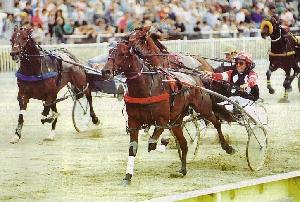 |
| Master Musician and Robert Dunn win the Derby |
Master Musician had to be the outstanding horse he is to resist the earnest efforts of Impressionist, Sogo and Tartan Clansman in the John Brandon 30 NZ Derby. And Stabilizer might have joined them, too, had David Butcher chosen to leave Mac Magpie's back in the early stages of the race rather than later, when the others were splitting up the prizes.
Impressionist was forced to work a little hard until he got to the lead at the 2000 metres. At that stage, Master Musician, who was able to follow Cadillac Jack forward, was fourth, trailing sweetly on the outer, and Tartan Clansman was behind him. Stabilizer, who was second at the 2300m, was four deep and 7th at the 2000m. Just as he did on the middle night, Robert Dunn put Master Musician into open country near the 750m. He joined the attack before the corner and fought his way clear. His pursuers weren't easy to shake off. Tartan Clansman tried hard to stick with him, Impressionist didn't submit without a fight, and Sogo emerged to battle past the pair right at the end and ran Master Musician to a short length.
It took Master Musician 3:13.5 to complete the mobile 2600m, and only Winning Blue Chip, who won the Derby last year in 3:12.2, has gone faster among those of his age. A son of New York Motoring, bought for $37,000 at the International Sale, Master Musician is raced by Ken McDonald and Eugene Storck, who are scrap metal dealers, and Dunn. Outside of his $500,000 won on bonuses, Master Musician has now earned $772,414, the result of 14 wins and a third from 16 starts.
As he did on the second night, Mr McDonald paid tribute to veterinarian Dr Peter Gillespie who has monitored the health of his young champion so carefully these past few weeks. Said Dunn: "He has a tie-up problem and he seems to pick up a virus so easily. The checks Peter has been able to give him have been vital."
Dunn, aged 36, said the win had been a great thrill, and rivalled that of National Glory in the Sires' Stakes Final. "We've really had so many over the last two or three years, it's hard to choose," he said.
Credit: Mike Grainger writing in HR Weekly
YEAR: 1991
FEATURE RACE COMMENT
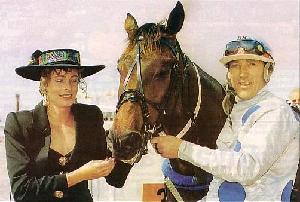 |
| Katrina Purdon, Chrisopher Vance & Tony Herlihy |
Christopher Vance won the 1991 DB Draught NZ Cup with a surprisingly good race that simply reflected the big-race temperament and experience of Tony Herlihy.
While Starship made a flyer from wide out, and Master Musician didn't waste any time, Herlihy had some lucky breaks getting Christopher Vance through from the second line and was soon seventh and improving. There were some who made a mess of the start, notably Defoe which was no surprise on his recent behaviour and Blossom Lady, who went away safely but then lost stride.
By the time they caught up, which wasn't long because the pace was so tediously slow, Herlihy had worked Christopher Vance into the trailing spot behind outsider Surmo Way. Robert Dunn had Master Musician buried on the rails behind Clancy and in front of Lord Magic, while Mark Purdon had no complaints with the lie of the land as he tracked up Christopher Vance. The Bru Czar was back on the outer, and with him were Two Under, Stratum and Insctcha.
Once the lines were set, there was no change. The Bru Czar or Two Under may have been expected to make a move on the first lap, even at the mile, but they stayed where they were. It was obvious with a lap to run, with a sprint home certain to develop, that the front bunch had it made. Any hope of a spectacle was right out the window.
Gary Hillier stepped on the gas with The Bru Czar passing the 800 metres, and Mark Hanover came out to force him three wide only to gallop and lose all chance at the 600 metres. In the meantime, Dunn had Master Musician moving sweetly inside The Bru Czar and right behind Christopher Vance, who was now three wide at the 400 metres and closing hard. What apparently happened then, according to stewards, was interference caused by The Bru Czar which forced Master Musician onto Clancy's wheel and into a break.
This had gone on behind Surmo Way, who has bravely passed Starhip and taken, briefly, a narrow lead. But the favourite quickly had his say, and ran ahead to beat Clancy, The Bru Czar (later relegated to 13th), the game Surmo Way and the stablemates Insutcha and Mark Hanover.
The race was a pressing bore.
Many who thought it was a tame affair when Neroship won the Cup in 1990 now consider that event quite exciting. Said one regular enthusiast:"At least in that there were five lead changes. In this one the horse that led out, led into the straight, and they all sat back on a 2:05 first mile.
Credit: Mike Grainger writing in HR Weekly
YEAR: 1991
FEATURE RACE COMMENT
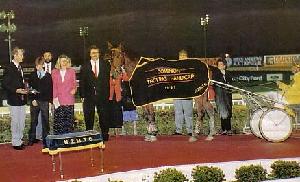 |
| The connections pose with William Dee. |
Having won a New Zealand Cup, an Auckland Cup, an Inter-Dominion Pacing Grand Final and an Inter-Dominion Trotting Grand Final, John Langdon had no summits to climb. The record book is not the best guide of such events, however, because Langdon knew he had another big one left. "One of my ambitions long before I started out in my training career was to win a Dominion Handicap. I have always loved trotters. It's a skilful job getting a trotter right. To win a Dominion, I feel I've really achieved something as a trainer," he said.
Langdon reached that special peak with William Dee, the Canterbury-bred 7-year-old son of 1979 Dominion Handicap winner Alias Armbro who raced like a Panzer tank and didn't stop for anyone. Langdon drove him hard, the way William Dee likes it. He was a little concerned racing over the first 800 metres that his charge wasn't as sharp as he should have felt, but further on he started to feel better. After being caught a little wide early, then pressed on and reached the front 1700m out, where they stayed, winning in the end by a length and a half from Gee Du Jour, who ran right up to her best form. The rain was a blessing too. Langdon at first believed William Dee was no great shakes on puggy or soft tracks, but as he does such a lot of his work at home on Langdon's sand track there were no alarms in the camp. "The rain came just at the right time. He was just starting to feel his feet a bit, and this made a bit of a difference," he said.
William Dee now races without the gear he had when Langdon first started training him. "He had a hood with pacifiers, a noseflap, and a brush as well. It worried me a little about the dirt coming back but it hasn't bothered him," he said.
Now the winner of 17 races from 58 starts, William Dee will be kept on a busy detail, with racing coming up at Thames, Auckland, Cambridge and Melbourne Inter-Dominions. William Dee was bought by Kevin O'Gorman, one of four partners in the horse, as a 3-year-old on the recommendation of Murray Lawson. Mr O'Gorman, a stalwart of the Marist senior forward pack for 13 years, had been a dabbler for 20 years, his first attempt being Pamela Queen, a pacer by Winterlight he had with Ray Morris. "I had odds and sods after that, but nothing of note until Idle Pride and William Dee," he said.
William Dee had raced once, on the West Coast as a 3-year-old when Mr O'Gorman bought a half share, but early opinion about the prospects of the relation to former top trotting mare Harbour Light were not encouraging. He was sent to Mankind Lodge, where veterinary surgeon Merv Williamson operated on a leg and made a start on his preparation. "When Jack Carmichael didn't take him, I sent him back to Bevan Heron and he won six races with him. It was when Idle Pride looked like winning as many - and Bevan thought 'Pride' was better - that I decided to send William Dee up to John Langdon's. I consider he has been underrated. He hasn't had the limelight some of the others have had," he said.
Credit: Mike Grainger writing in HR Weekly
| << PREVIOUS | 1 2 3 4 5 6 7 8 9 10 11 12 13 14 15 16 17 18 19 20 21 22 23 24 25 26 27 28 29 30 31 32 33 34 35 36 37 38 39 40 41 42 43 44 45 46 47 48 49 50 51 52 53 54 55 56 57 58 59 60 61 62 63 64 65 66 67 68 69 70 71 72 73 74 75 76 77 78 79 80 81 82 83 | NEXT >> |